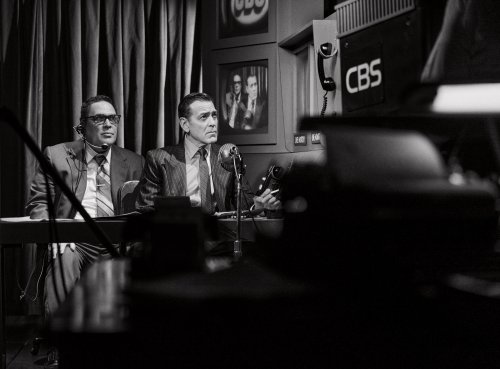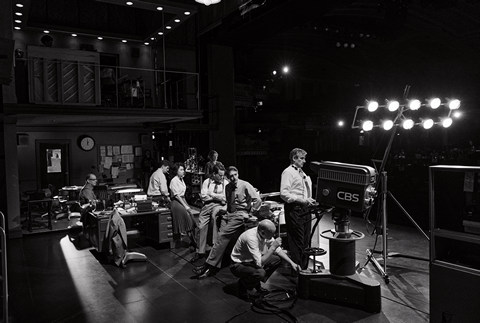Good Night, and Good Luck.
Contains a tremendously important message about integrity and media responsibility which is even more relevant now in the age of fake news than it was when the film was release 20 years ago.

Paul Gross as William F. Paley and George Clooney as Edward R. Murrow in a scene from the Broadway production of “Good Night, and Good Luck.” at the Winter Garden Theatre (Photo credit: Emilio Madrid)
If only film star George Clooney and his co-script writer Grant Heslov had hired an actual playwright to adapt their acclaimed screenplay for the 2005 film Good Night, and Good Luck. for the Broadway stage. What worked in close-up in the film does not have the same effect on the huge stage of the Winter Garden Theatre. And while David Strathairn as Edward R Murrow in the film, the role now played by Clooney on Broadway, also seemed wooden and unemotional, every flicker of emotion on his face was telegraphed through the extreme close-ups of every frame. With its cast of 22 on a huge CBS studio set, most of the characters are undefined or unidentified. At times it is difficult to know who is talking or where their voices are coming from on the multileveled setting.
This is all a pity as the play has a tremendously important message about integrity and media responsibility which is even more relevant now in the age of fake news than it was when the film was released 20 years ago. The impact of the play is still the most powerful of any play currently on Broadway but that is due to Murrow’s powerful indictment of American journalism afraid to dissent from bad government policy. Now more than ever, this is a message that needs to be publicized when the media and law firms are afraid to speak out against fascist and anti-democratic policies. We are living in age when the McCarthyism of the 1950s seems to be here again.
The play as did the film begins with “Ella,” a jazz singer (Ella Fitzgerald?), performing a famous song as she does between most of the scenes. This worked better in the film where it took place in a night club where the CBS staff showed up to relax over drinks after work. However, here it appears to take place in a sound studio at CBS. Not all of Ella’s songs are the same ones from the film; however, all comment in some way on the action.

Glenn Fleshler as Fred Friendly and George Clooney as Edward R. Murrow in a scene from the Broadway production of “Good Night, and Good Luck.” at the Winter Garden Theatre (Photo credit: Emilio Madrid)
A spotlight comes up on a podium on October 15, 1958, at the Radio and Television News Directors Association’s annual meeting, with Murrow as the night’s guest speaker. He makes his now famous speech criticizing the media news as guilty of “decadence, escapism and insulation from the realities of the world in which we live.” After he damns his field for its “being used to distract, delude, amuse and insulate us,” the speech is cut off and we find ourselves in the CBS Studio and the writer’s room of Edward R. Murrow’s news program called See It Now back in 1954. The team watches the footage of Senator Joseph McCarthy’s Permanent Subcommittee on Investigations question Annie Lee Moss, one of three in the District of Columbia phone book, a Black civil servant accused of being a Communist but without much evidence. However, Murrow nixes the story for their program as they cannot prove that McCarthy is lying.
We then see recreated Murrow’s telecast on former Lt. Milo Radulovich of the Air Force Reserves, a loyal American, who had been removed from service because it was found that his father was found to have read a Serbian newspaper. The evidence against Radulovich and his family was never revealed publically but supposedly appeared in a sealed envelope. Murrow concludes privately that McCarthy is behind the removal.
An army colonel objects to the episode before it airs but he is informed by Fred Friendly, Murrow’s producer, that he was informed about it in order to comment on the show not approve it. Then Don Surine, chief investigator for the House Un-American Activities Committee comes to William F. Paley, head of CBS, with supposed evidence that Murrow was a Communist back in the 1930’s. Expecting to be McCarthy’s next target, Murrow decides to do an episode exposing him but using only his own words, in particular the notorious Reed Harris investigation in which McCarthy referred to the American Civil Liberties Union as having been listed as a front for the Communist Party although it had never been so listed.

Glenn Fleshler as Fred Friendly, George Clooney as Edward R. Murrow, Paul Gross as William F. Paley, Carter Hudson as Joe Wershba and Ilana Glazer as Shirley Wershba in a scene from the Broadway production of “Good Night, and Good Luck.” at the Winter Garden Theatre (Photo credit: Emilio Madrid)
Murrow announces first that if he does violence to the senator’s words he will be given an opportunity on See It Now to defend himself. When McCarthy takes them up on Murrow’s offer of a rebuttal, he tells so many lies about Murrow that Murrow uses his next broadcast to set the record straight. This is the beginning of the end for Senator McCarthy. The play ends with the conclusion of Murrow’s 1958 speech, partly inspired by his firing from See It Now because his controversial telecasts on See It Now had cost CBS their sponsor. He ends by reminding his listeners that the news media can teach, illuminate and even inspire, but “only to to the extent that humans are determined to use them to those ends.” The play ends (as the movie did) with a devastating montage of television moments that could be considered as the turning point in publicizing fake news, which on stage goes right up to 2025.
The program does not identify the 22 characters but the script (which the audience will not have) does, a very useful tool for these 1954 personalities most of whom are unknown today. Very few of them are given personalities or are delineated and those that are represent archetypes and exemplars. Clooney’s Murrow remains the same throughout, humorless and dour. As his producer and head writer, Glenn Fleshler’s Fred Friendly seems like someone on the way to an ulcer. Elegant Paul Gross is suave and urbane and one note as their boss, William F. Paley, President of CBS. (In the film Frank Langella’s Paley became angrier every time he met with them, warning us their days were numbered.)
Among the very few characters who are fleshed out other than their jobs, the story of Ilana Glazer and Carter Hudson as a couple who are married despite company rules are not given enough stage time for their story to have much impact. As news reporter Don Hollenbeck who pays the price for Murrow’s investigation, Clark Gregg is suitably tense and nervous. Georgia Heers as the jazz singer Ella has a very impressive delivery and a mellifluous voice, but it would have been better to tie her singing into the story line, not just the themes of her numbers. Most of the other actors play names without a function. Director David Cromer (Our Town, Prayer for The French Republic, The Band’s Visit, to name only a few) is usually better at distinguishing his characters in his large cast plays.

The cast of the Broadway production of “Good Night, and Good Luck.” at the Winter Garden Theatre (Photo credit: Emilio Madrid)
While Scott Pask’s setting for the CBS News room, Friendly and Paley’s offices, the writers’ room, and a piece of a railroad station (CBS News was in Grand Central Station in those days), the massive set is both distracting and hard to track. Many sections remain unnamed while others like the editing room seem to be used for many purposes. The biggest single element in the play is David Bengali’s projection design which uses most of the same documentary clips that appeared in the film but not all (the Liberace Person to Person episode is a case in point.). Brenda Abbandandolo has created an impressive array of 1950’s suits for the men and business attire for the women. Bryan Carter who heads the onstage four piece combo is also responsible for orchestrations and arrangements.
Good Night, and Good Luck. by George Clooney and Grant Heslov is not a failure as it has a very powerful message but as it stands it is a film script shoehorned onto a stage. While it has the advantages of its film story, it remains remote from the audience as most of the film footage is shown from the back of the stage, far from the viewers. It also never gets under the skin of the characters as the close-ups were able to accomplish in the film. It is to be hoped that when Clooney returns to the New York stage, he will have a stage vehicle worthy of his talents.
Good Night, and Good Luck. (through June 8, 2025)
Winter Garden Theatre, 1634 Broadway at 51st Street, in Manhattan
For tickets, call 212–239-6200 or visit http://www.goodnightgoodluckbroadway.com
Running time: 100 minutes without an intermission






Leave a comment